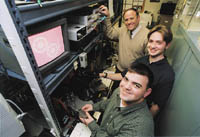No big deal
Relying on the same techniques used to create computer chips, Engineering Prof. Ed Kolesar and his students are developing a microscopic motor.
No big deal
Relying on the same techniques used to create computer chips, Engineering Prof. Ed Kolesar and his students are developing a microscopic motor.
| Small thinkers. Engineering undergrads Matt Ruff (front) and Richard Wilks are helping Engineering Prof. Ed Kolesar develop a microscopic motor that will one day be attached to a lens in an artificial eye. |  |
![]()
Slice a hair into 100 widths.
Take one of those slices, and you have a micron — about 15 atoms stacked. And that’s the size of the motor Engineering Prof. Ed Kolesar built to power movement in an artificial lens that may one day be part of an artificial eye.
That microscopic machine can spin at more than 10,000 rpm.
Mind boggling?
Not to Kolesar, who has been working with MEMS, or microelectromechanical systems for more than 20 years now.
“We basically are just taking dimensions usually measured in feet and reducing them to microns,” he said. “It’s no new-fangled technology.”
But TCU is the only university in Texas taking the silicon devices to such extremes. Kolesar and his choice undergraduate researchers design the machines in a TCU lab, then send them to a semiconductor plant to be manufactured.
The same techniques used to create computer chips are employed to build Kolesar’s motors. Though the creation of a viable artificial eye is still years away, the “muscles” that will move the lens of that eye are already getting a workout in Kolesar’s lab.

Your comments are welcome
Comments
Related Reading:
Campus News: Alma Matters
TCU’s Library Celebrates a Century
Uncover hidden gems of the academic hub, from vintage mechanics to modern masterpieces.
Campus News: Alma Matters
Infographic: TCU’s Shared Values
The Board of Trustees adopted four TCU values after considering input from more than 4,000 constituents.